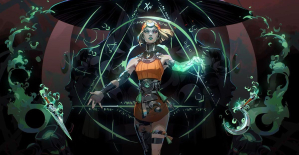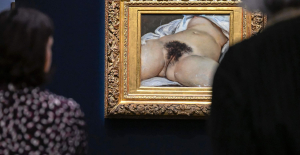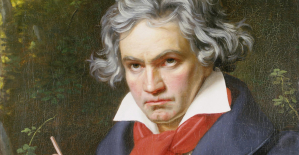On the cover and in chiaroscuro, the silhouette of three young men, arm in arm, drunk. In title and capital letters: The Illuminated. Rimbaud, Verlaine and Germain Nouveau. Three poets. For a moment, we feared that this comic would serve us yet another version of the passionate affair between Rimbaud and Verlaine. It is certainly a question, but it goes much further. The prologue sets the tone. In great silence, the Gothic porch of a cathedral carved in a fade of white and ocher occupies the entire surface of the first double pages. Foreground: in the left corner, a small character, hat, stick, bag, is heading towards the porch. Second shot: here he is sitting on the side, a plate in front of him to ask for alms, while a woman comes forward. Third shot: the man watches the woman open the church door. This introduction, we will understand at the end, is the epilogue of the story which is about to begin. We will have to wait until the last pages to discover who this glorious beggar is, inspired by another divine tramp, Saint Benedict Joseph Labre.
In the meantime, one day in September 1872, here is Germain Nouveau, who discovers Paris, arriving from Aix-en-Provence, a pure young man who dreams of being a poet. And there, across the Channel, Rimbaud and Verlaine on the train to London talking about poetry. Verlaine, anxious. Rimbaud, shady. The narration is on two levels: at the top, the dark sepia boxes follow Germain Nouveau, at the bottom, in sepia tinted with green, Rimbaud and Verlaine.
The story progresses throughout in this way, and it is surprisingly clear even though there is no narrator. The drawings, the dialogues, all magnificently elliptical and deep, are enough to grasp what is happening. In the second sequence, a year later, we will see how Rimbaud and Nouveau meet in Paris, while Verlaine is alone in prison in Brussels. Later, Verlaine and Nouveau will get to know each other while Rimbaud stays in Charleville-Mézières. The narrative process is powerful as a metaphor, full of meaning.
Between each chapter, there is a narrative and temporal break, marked by a new view of the porch of the cathedral, sublime in its simplicity, a rock of beauty in view of the paradoxical desires, the moral and spiritual tortures of the heroes.
The story is built around the manuscript of Illuminations that Rimbaud left to Verlaine and Nouveau before fleeing to the Middle East to “embrace rough reality”, to live in real life: because he lost faith in the power of words and understood that literary glory was vain. Fascinating like a fallen angel or a Shakespearean hero, he could have said like Hamlet: “Words, words, words.” But the final word will be for the wise beggar on the porch: “Being or not being published has greatly prevented me from living. Today I live. And when I write, it’s like when I eat, when I walk, when I laugh, when I pray. It’s my way of being alive.” Sumptuous.
It starts like a dark novel. Spring 1940. In a Paris street at night, a naked young woman runs and collapses. She looks terrified. Without any transition, we find ourselves on the Maginot line where we meet two other characters. Raoul, a sneering soldier, used to shenanigans, and his big-eyed, wild-eyed chief sergeant, Gabriel. Soon Raoul will force Gabriel to desert with him. Back to Paris. The young woman, Louise, explains to the police that she witnessed the suicide of an old regular at the bar where she works. A drama that puts her on the trail of her late mother's past and the great love she experienced with a married man. You will have to wait until page 76 to understand the link between these two plots.
The scenes of the military debacle are followed by the twilight scenes of the exodus routes where all the characters will meet again: there is also Désiré, a cheerful usurper disguised as a priest who takes care of the refugees, and Fernand, a crazy mobile guard in love with his wife. This comic book adapted from a novel by Pierre Lemaître is romantic as hell, masterfully orchestrated and drawn by Christian De Metter. And against all odds, in the chaos, even the crooked guys give their best. Beautiful contrasting characters who compose a breathtaking and flamboyant fresco.
Standing on the roof of a building in Barcelona, at the height of the spires of the Sagrada Familia, Eva, beautiful and sovereign, stares into space. Below, on a terrace, a frightened man, with beard and glasses, begs her to come down. A psychiatrist, he was appointed to assess the mental state of the young woman, one of his colleagues, considered eccentric by some. Right away, we love this Eva. Model figure, urban cowgirl look, wild hair, childish face, competitive IQ, extravagant and irreverent. A go-getter and a dreamer. Crazy? No, she defends herself: the three women with whom she has an internal dialogue are not hallucinations, but her deceased aunts and grandmother who raised her and about whom she thinks.
This comic book by Jordi Lafebre, an author-cartoonist from Barcelona, could be reminiscent of the French HPI series. But no. It is otherwise impactful, more subtle, aesthetically sharp and lively, violent like a noir novel despite the tangy colors and the sparkling light line of the drawing. The story unfolds from the shrink's office who asks Eva to tell him about her week. He won't be disappointed and neither will we. She found herself involved, of her own free will and with greedy imprudence, in a dark story of a rich and large family. A will, a corpse… Eva throws herself headfirst into the investigation despite the warnings of Inspector Merkel, a strict woman who will play an unexpected role in her life. I Am Their Silence is a comedy where repartees burst forth, and a moving and very fine psychological thriller which explores the fragilities of strong personalities.
Imagine lonely Lucky Luke with two unbearable children on his hands. What a brilliant idea Blutch had, paying homage to Morris' hero in an irresistibly entertaining album. We read it with the same innocent pleasure as when we were 10 years old. Two children then. Casper is a happy idiot stubborn as a mule who has crazy ideas, and his little sister Rose is an exquisite pester who is not afraid of anything or anyone and makes it known. It looks like Ma Dalton and Averell at 6 and 7. Here is our very embarrassed cowboy. Their older brother is in prison and their parents, high-level gangsters, fled with the loot from their last heist so as not to share it with their accomplices. Of course, they are on their trail and boosting the house of the nice little family.
Lucky Luke doesn't know where to turn anymore. The children show him all the colors. He entrusts them to the teacher, who excludes them after a day, then to his friend Maybel, the leg lift artist, who runs the saloon: there, the two kids have a field day, but the respectable Rombieres of the town became indignant and took over, before passing the babies on to the Comanche chief of the neighboring reserve! Incidentally, Blutch paints a humorous picture of a small town with its never-happy notables and its fearfully ineffective police force. A crazy chase in search of irresponsible parents will crown the story. The author dedicated this album to his children. It will delight all generations. Guaranteed laughs.
Paul has a vague soul. His wife left him a few years ago, he lost his mother, then his father. He is dried up, is considering changing careers. Her daughter, Rose, 23, takes matters into her own hands. She rents a shack on an island in the St. Lawrence estuary: water as far as the eye can see, the starry sky, rocks, no 4G, a handful of inhabitants and wooden houses enveloped in forest, all drawn with wonderful attention to detail and touch by Michel Rabagliati. Those who are familiar with the autofiction comics of this great Quebec author-cartoonist and his alter ego, Paul, will happily rediscover this character whose chronic melancholy is matched only by his humor.
But in this new album, Rabagliati goes further. He jumps into the void of the page. No bands, no boxes. He abandons ink and the pen, preferring the soft tip of the pencil. The text and drawings fit together freely. Unity of tone, variety of points of view: we are captivated by the calm of the places and the beauty of the graphics. The author has no equal when it comes to putting poetry into prosaic details. The character of Rose, with her long vintage floral dress and her outspoken Quebecois mixed with English, brings liveliness and freshness. Thanks to her and a funny baker, Paul ends up recognizing that “a luminous presence” inside him seems to want to help him. And if the little smiling character, in the cassock and black hat of the Jesuits of yesteryear, hidden in the landscape where Rose is the only one to see him at the start, had something to do with it?

 Israel-Hamas war: Gaza between hope of truce and fear of Israeli offensive in the South
Israel-Hamas war: Gaza between hope of truce and fear of Israeli offensive in the South “Mom, Dad, please don’t die”: in the United States, a nine-year-old child saves the lives of his parents injured in a tornado
“Mom, Dad, please don’t die”: in the United States, a nine-year-old child saves the lives of his parents injured in a tornado War in Ukraine: Putin orders nuclear exercises in response to Macron and “Western leaders”
War in Ukraine: Putin orders nuclear exercises in response to Macron and “Western leaders” Mexico: the last moments of surfers found in a well, killed with a bullet to the head
Mexico: the last moments of surfers found in a well, killed with a bullet to the head A baby whose mother smoked during pregnancy will age more quickly
A baby whose mother smoked during pregnancy will age more quickly The euro zone economy grows in April at its best pace in almost a year but inflationary pressure increases
The euro zone economy grows in April at its best pace in almost a year but inflationary pressure increases Children born thanks to PMA do not have more cancers than others
Children born thanks to PMA do not have more cancers than others Breast cancer: less than one in two French women follow screening recommendations
Breast cancer: less than one in two French women follow screening recommendations “A potential environmental disaster”: Paris town hall opposes an oil drilling project in Seine-et-Marne
“A potential environmental disaster”: Paris town hall opposes an oil drilling project in Seine-et-Marne The governor of the Banque de France pleads for the development of French and European AI
The governor of the Banque de France pleads for the development of French and European AI Clariane (ex-Korian) announces a sale of its home hospitalization activities
Clariane (ex-Korian) announces a sale of its home hospitalization activities To everyone's surprise, the Hades 2 event video game is released in early access
To everyone's surprise, the Hades 2 event video game is released in early access The Origin of the World, exhibited at the Center Pompidou Metz, target of an “artistic performance”
The Origin of the World, exhibited at the Center Pompidou Metz, target of an “artistic performance” Threatened with death for having insulted the mobilized pro-Palestinian students, Élie Semoun files a complaint
Threatened with death for having insulted the mobilized pro-Palestinian students, Élie Semoun files a complaint Vienna, Paris, Milan celebrate the 200th anniversary of Beethoven's 9th Symphony
Vienna, Paris, Milan celebrate the 200th anniversary of Beethoven's 9th Symphony Cannes Film Festival: call for strike one week before opening
Cannes Film Festival: call for strike one week before opening Omoda 7, another Chinese car that could be manufactured in Spain
Omoda 7, another Chinese car that could be manufactured in Spain BYD chooses CA Auto Bank as financial partner in Spain
BYD chooses CA Auto Bank as financial partner in Spain Tesla and Baidu sign key agreement to boost development of autonomous driving
Tesla and Baidu sign key agreement to boost development of autonomous driving Skoda Kodiaq 2024: a 'beast' plug-in hybrid SUV
Skoda Kodiaq 2024: a 'beast' plug-in hybrid SUV The home mortgage firm rises 3.8% in February and the average interest moderates to 3.33%
The home mortgage firm rises 3.8% in February and the average interest moderates to 3.33% This is how housing prices have changed in Spain in the last decade
This is how housing prices have changed in Spain in the last decade The home mortgage firm drops 10% in January and interest soars to 3.46%
The home mortgage firm drops 10% in January and interest soars to 3.46% The jewel of the Rocío de Nagüeles urbanization: a dream villa in Marbella
The jewel of the Rocío de Nagüeles urbanization: a dream villa in Marbella Europeans: David Lisnard expresses his “essential and vital” support for François-Xavier Bellamy
Europeans: David Lisnard expresses his “essential and vital” support for François-Xavier Bellamy Facing Jordan Bardella, the popularity match turns to Gabriel Attal’s advantage
Facing Jordan Bardella, the popularity match turns to Gabriel Attal’s advantage Europeans: a senior official on the National Rally list
Europeans: a senior official on the National Rally list Blockade of Sciences Po: the right denounces a “drift”, the government charges the rebels
Blockade of Sciences Po: the right denounces a “drift”, the government charges the rebels These French cities that will boycott the World Cup in Qatar
These French cities that will boycott the World Cup in Qatar Foot: Italian football protests against a government project which aims to monitor club finances
Foot: Italian football protests against a government project which aims to monitor club finances Champions League: “We are ready for anything,” warns Edin Terzic before PSG-Dortmund
Champions League: “We are ready for anything,” warns Edin Terzic before PSG-Dortmund Premier League: David Moyes to leave West Ham at end of season
Premier League: David Moyes to leave West Ham at end of season Transat CIC: Yoann Richomme winner in the wake of Tabarly, Poupon, Peyron, Desjoyeaux...
Transat CIC: Yoann Richomme winner in the wake of Tabarly, Poupon, Peyron, Desjoyeaux...


















